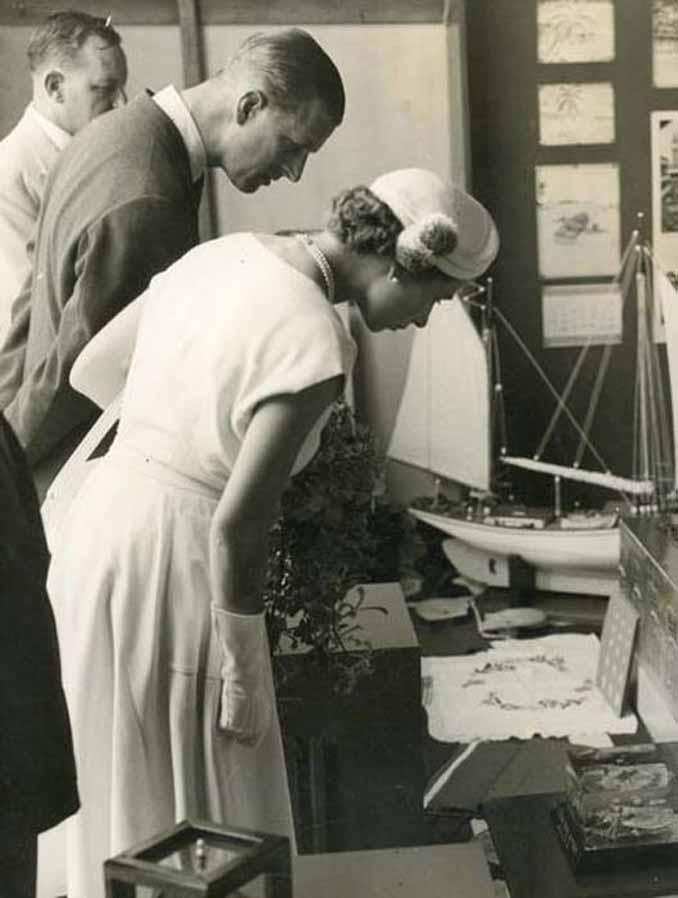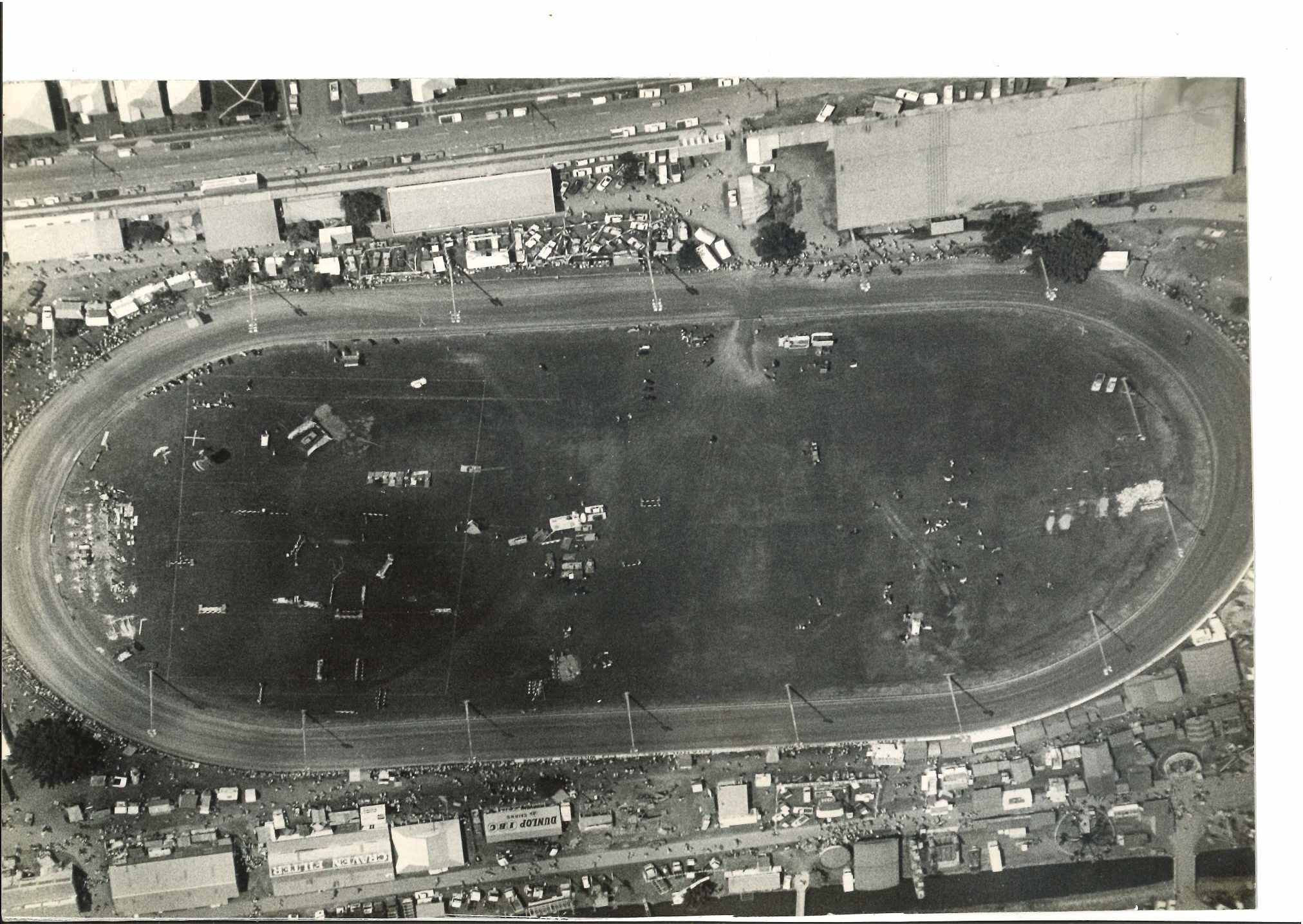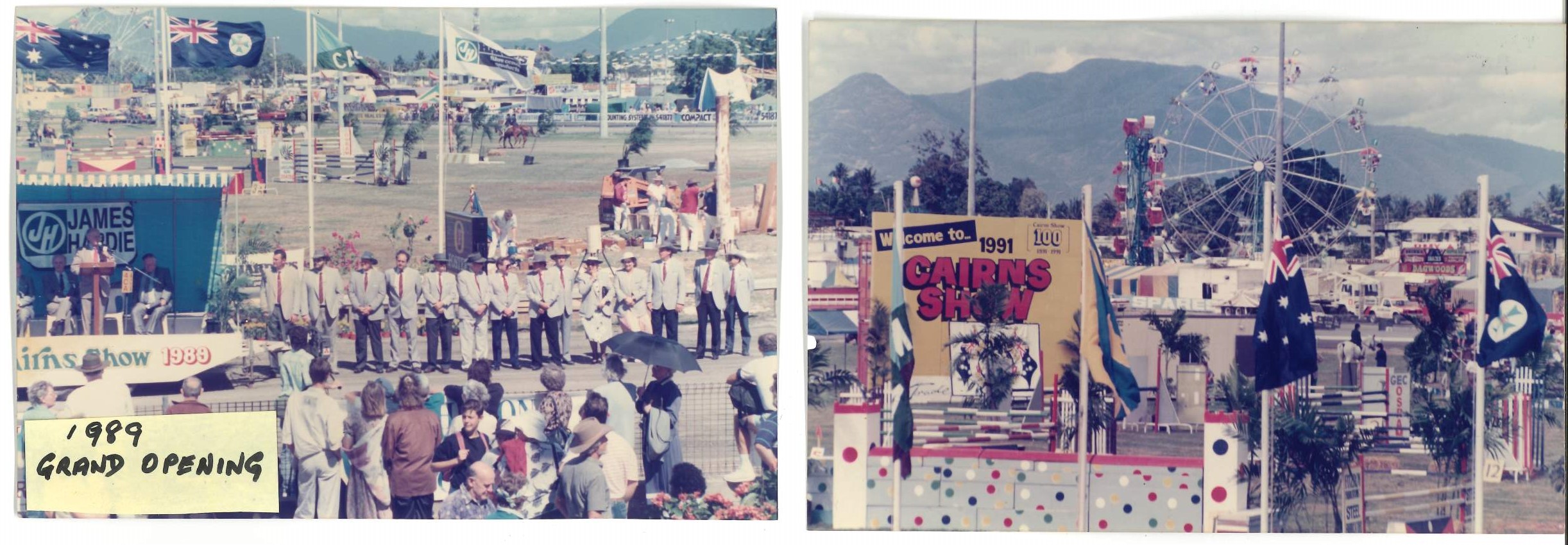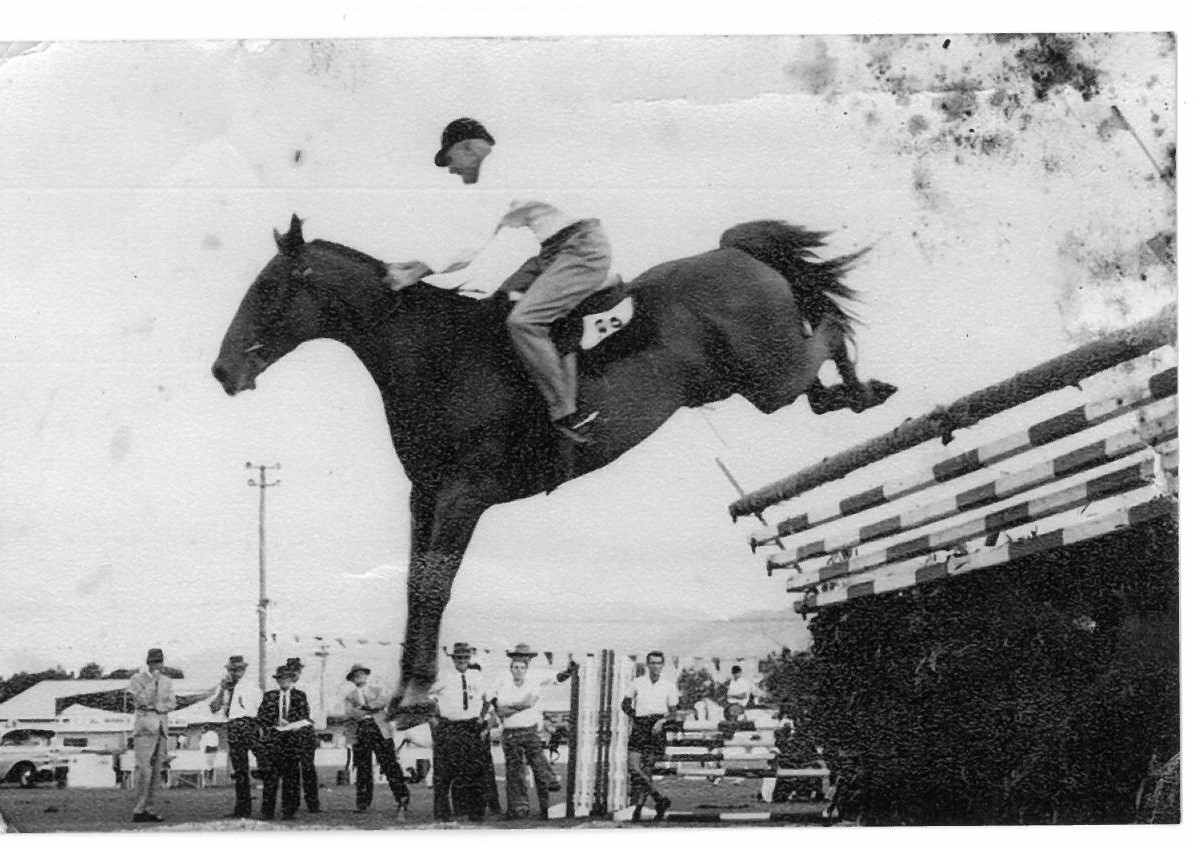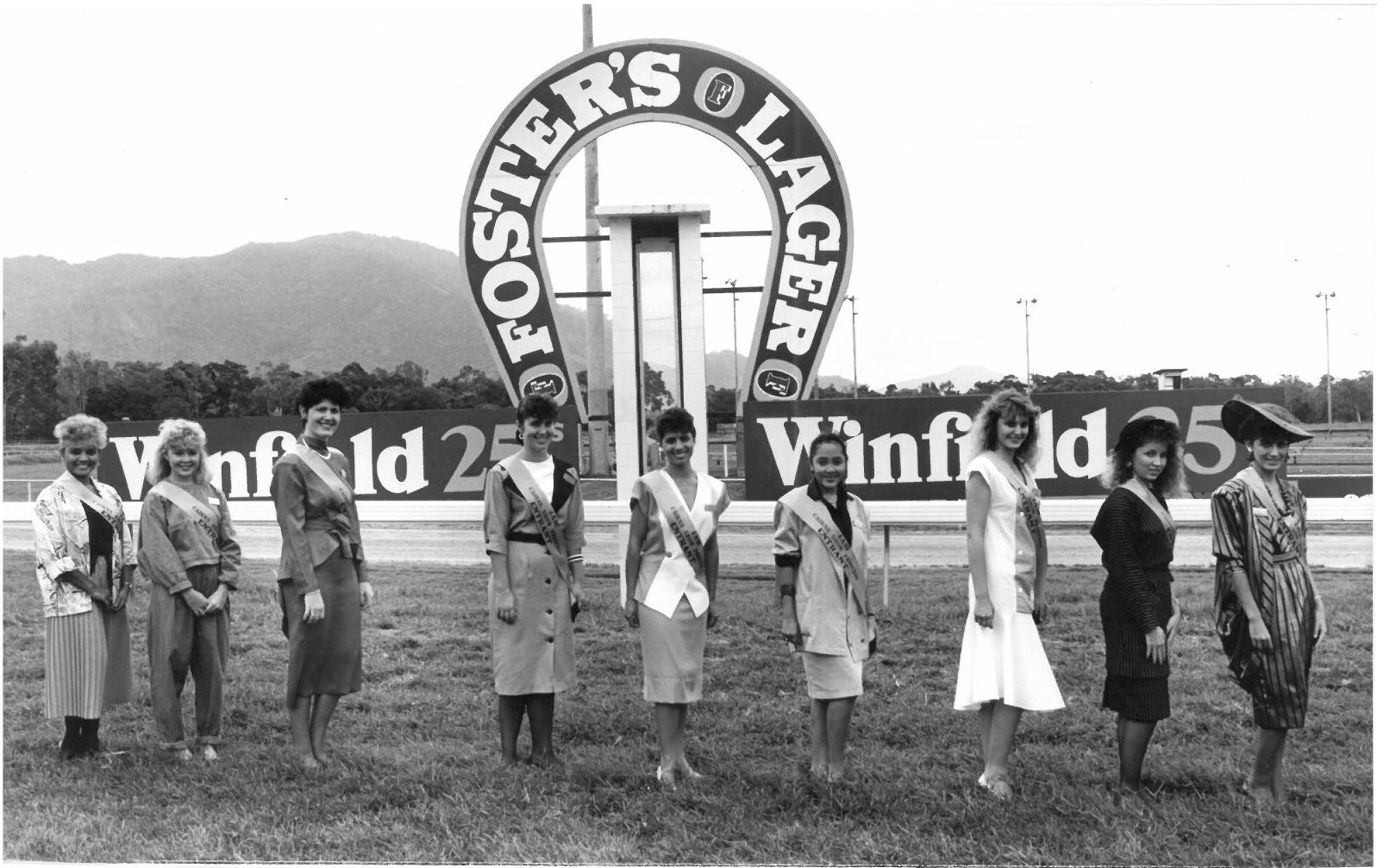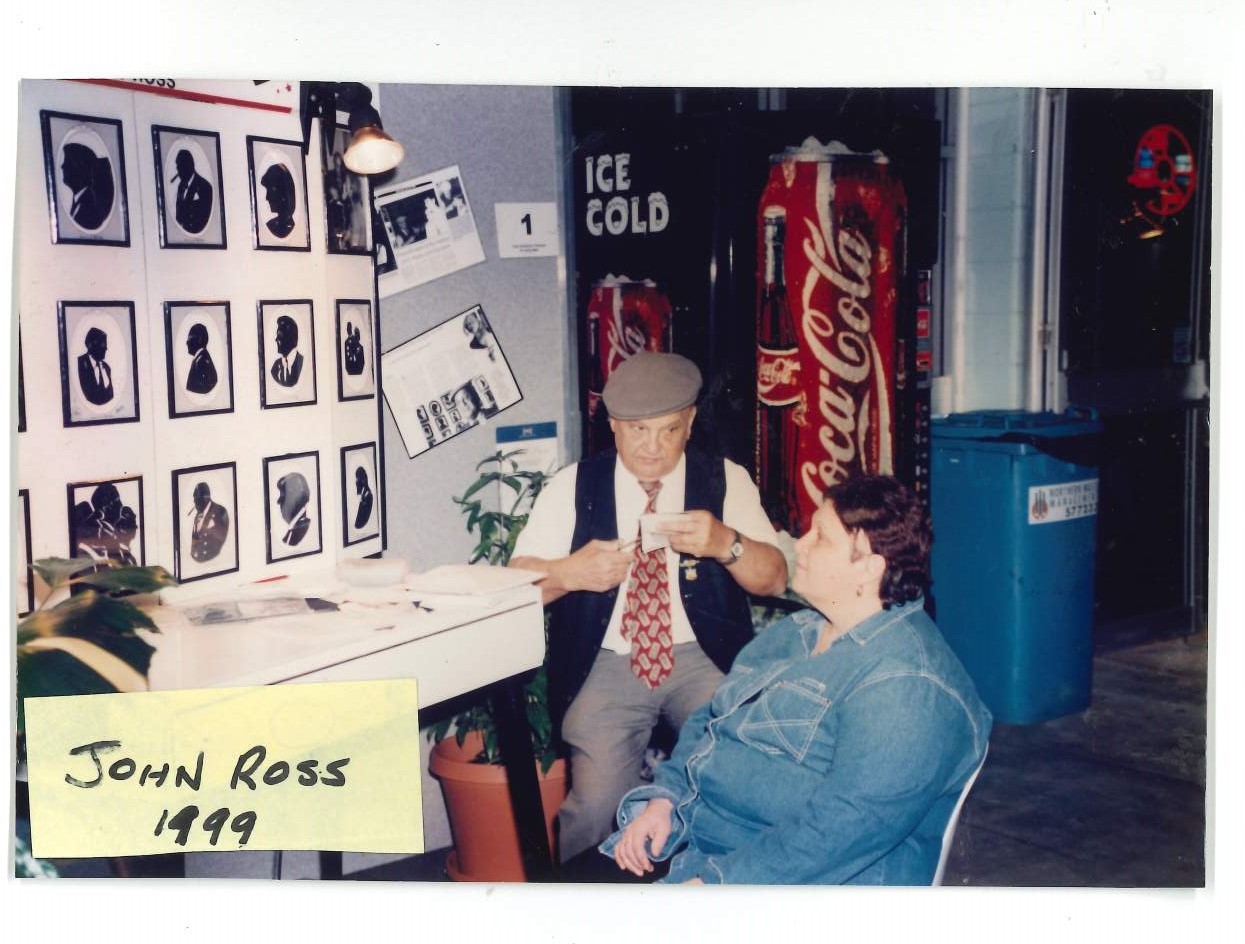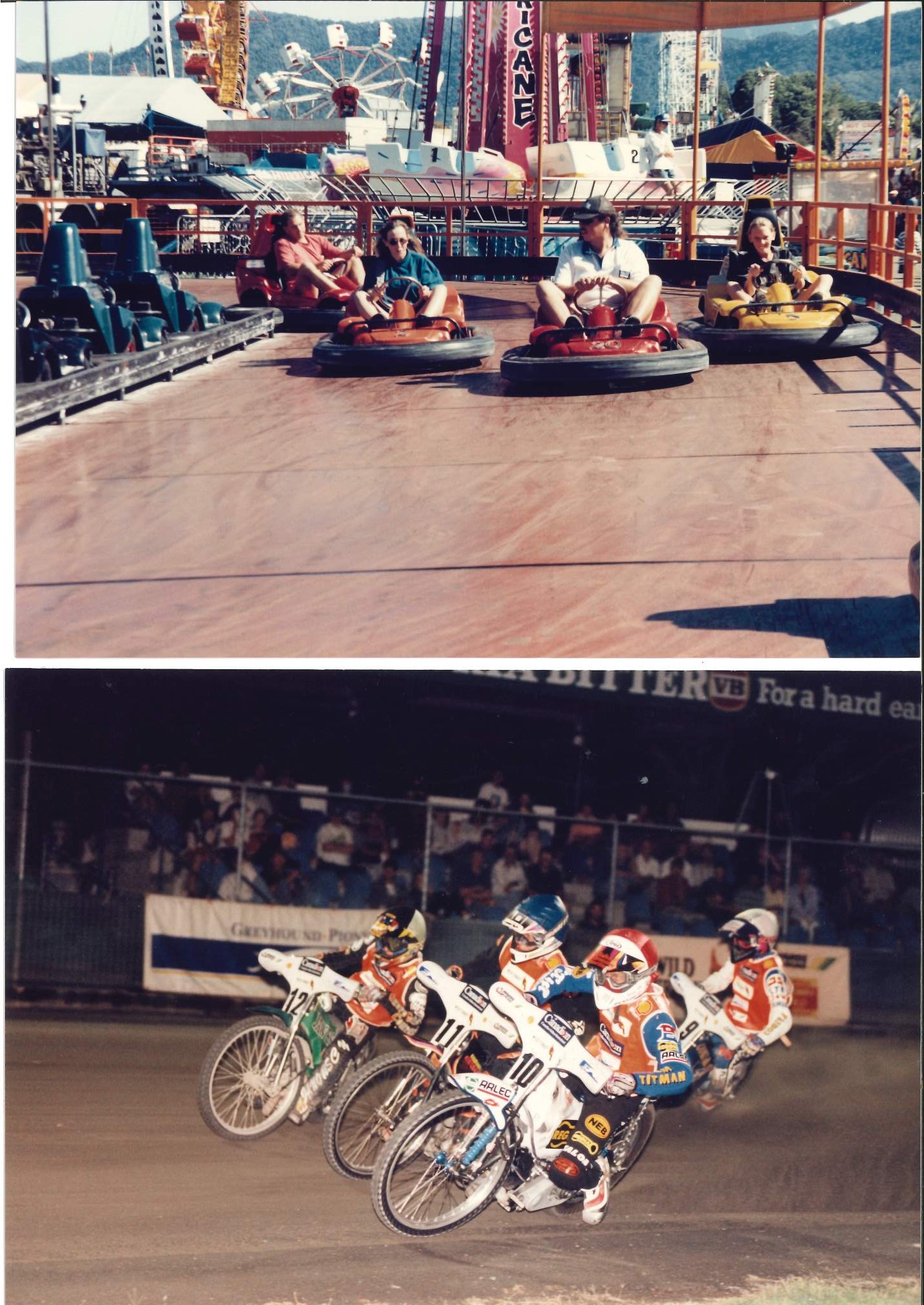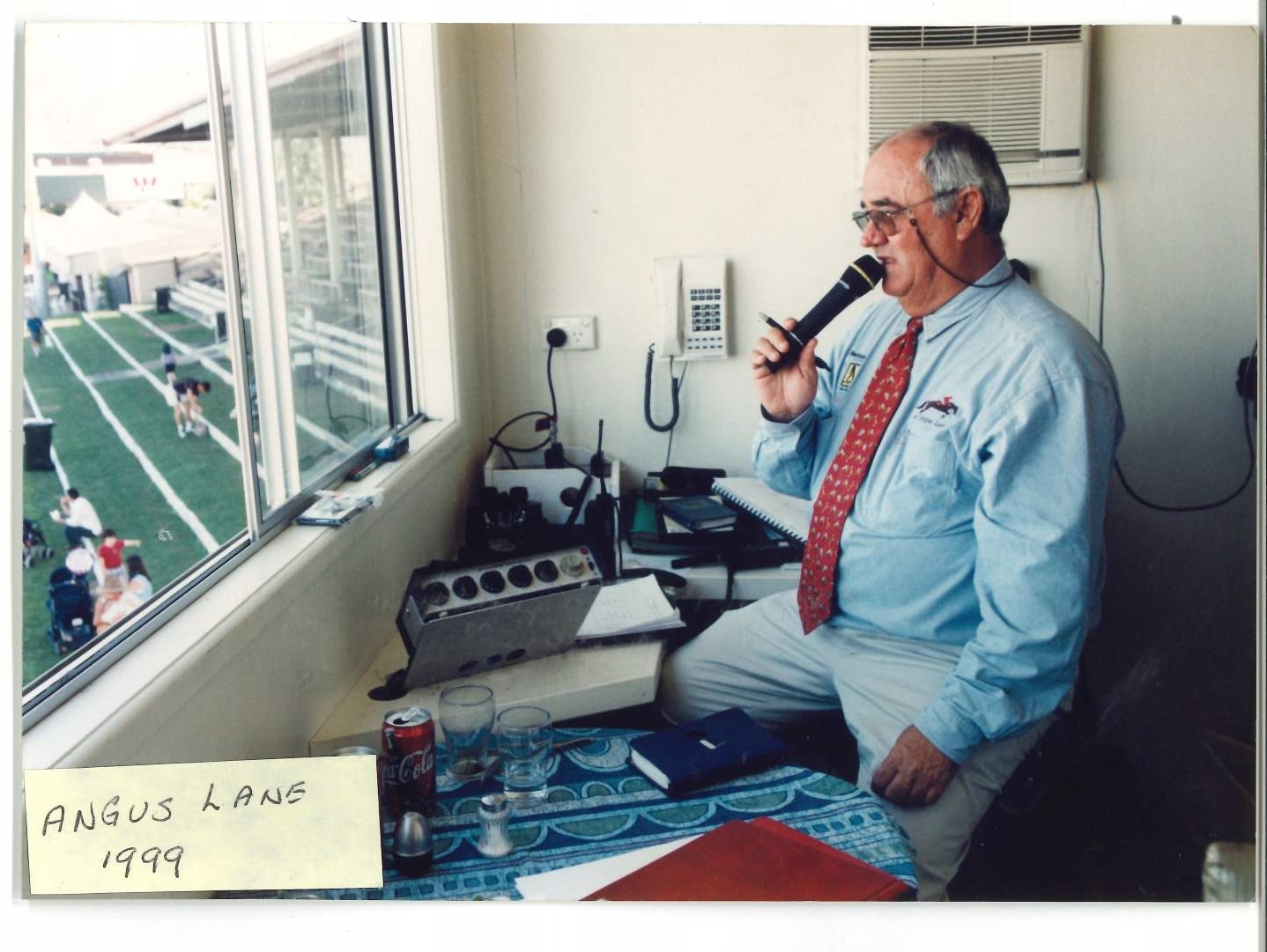THE HISTORY OF THE CAIRNS SHOW
WHERE IT ALL BEGAN…
The first show was presented by the Cairns Agricultural, Pastoral and Mining Association, which took place on September 9th, 10th and 11th in 1891.
It was divided into two sections. The Hall Show displayed a wide variety of exhibits in the Divisional Hall (which later became the headquarters of the Mulgrave Shire Council) for one day and two-night sessions. Judging of cattle, pigs, poultry and the traditional horse events provided the two-day program for the outdoor segment.
The first Cairns show-ground was a twelve-acre reserve between James and Thomas Street, adjacent to the two-mile peg on the original rail line running north from Cairns. One hundred and sixty-one pounds and nine shillings was initially spent on grubbing and clearing, fencing and other permanent improvements. The outstanding success of the Show justified the expenditure. The 1891 Cairns Show was officially opened during the first evening of the Hall Show by the Mayor of Cairns, Mr A J Draper, in front of a crowd of three hundred.
Shows in that format continued at the same locations until 1899 when a portion of property known at the time as Pryn’s and adjoining the original hotel at the “Four-mile,” was procured. Part of this site is the current location of the Woree Tavern on Mulgrave Road.
The public traveled considerable distance by horse and sulky to attend the Show at the new location which, in those days, was well out of town. Most traveled on regular train services from Cairns and Gordonvale, provided by the Cairns Mulgrave Tramway, during the first few years at the new location. Attendance on the first day in 1903, reached 1,000, increasing to between 1,200 and 1,300 on the second day. Paying a fee of six shillings per foot frontage in 1905, Abdul’s Sideshows were the first to operate in conjunction with the show.
A MAJOR BLOW…
Total Destruction of the few permanent buildings at the “Four-Mile” showgrounds occurred in a severe cyclone in 1906. All the structures were built on borrowed money, leaving the Association in deep debt. A lottery was sponsored in 1908, to “Aid in wiping off the liability to the Cairns Penny Saving’s Bank, the main security of which had ben destroyed”. The first of several valuable prizes offered, was a block of land situated at the corner of Sheridan and Shields Street and valued at £300. This is the present location of Fasta Pasta. Second prize consisted of five acres of land opposite the Railway Station at Stratford, valued at £30.
The amount of profit that resulted is unknown, however, it was shown in the Annual Statement for 1910 that the Association still owed the Penny Savings Bank £243/12/10. This was in addition to a further £117/3/3 owing to the Queensland National Bank.
Despite the financial pressures, perseverance and public support remained strong, with record attendances enjoyed during both the 1910 and 1911 Shows. However, cycle racing under lights at Norman Park in the centre of town began drawing big crowds, resulting in declining interest and the discontinuation of Shows from 1912 through to and including 1915.
A NEW LOCATION…
Following lengthy discussions and renewed public interest, the Association’s activities were revived and a Show was held in 1916 on September 21st and 22nd at the Woree Racecourse. An attempt to include a Hall Show in the Hibernian Hall at the corner of Lake and Florence Streets the same year failed through lack of interest and entries.
Incidentally, the first mention of the committee’s interest in the Parramatta Park Sports Reserve, which is the current Show site, was made in President W.J Houston’s Annual Report, presented in December of 1921. Shows were held at the Racecourse again in 1922 and 1923, before the show in 1924 proved to be the last held venue, and the last in that chapter of the Association’s History.
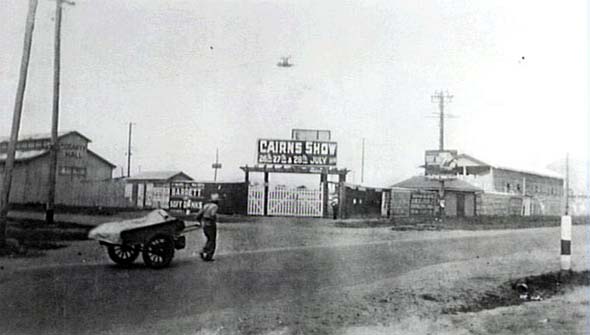
Photo of the Cairns Showgrounds, date unknown
Photographer: Unknown
Image sourced from: Cairns Then and Now… Facebook Page
A NEW BEGINNING…
It was a little embarrassing that a town the size of Cairns did not have an annual Show. Innisfail, Malanda and Ravenshoe, all with much smaller population were able to boast flourishing Show Societies. Cairns Mayor, Mr W A Collins, called a public meeting on February 24th 1931, in an attempt to revive the Cairns Show. A committee was subsequently formed with Mr R F G Fogarty as President, and plans immediately made for a Show to be held at Parramatta Park on July 29th and 30th, 1931.
At that time the Parramatta Park Sports Reserve consisted of a small area of usable ground, most of which had been filled by dry waste. Mangrove swamp skirted the ground to the south and to the west and high tides still invaded the narrow fringe areas. However, the committee successfully negotiated an agreement for shared use of the reserve as a show-ground.
Following several sizable donations, a contract was immediately arranged with local builders T B O’Meara and Sons for the construction of a pavilion at a cost of £650. Fogarty Hall was built where the Kevin Whouley show-bag pavilion presently stands.
Urgently needed fill material for the tidal southern part of the showgrounds was provided by the Cairns Harbour Board and the Cairns Council. Local businesses made lorries and drivers available, and coupled with the untiring efforts of the committee and a sizeable army of volunteers, the first stage of an all-important on-going fill program began.
Sponsorship reached a level far beyond expectation during those years of economic depression, and extended beyond providing, prize money for an extensive program in the main arena.
The largest Regional Show was a resounding success, returning a net profit of £ 1091/16/2. It also laid the foundation for the Cairns Show to develop into the best regional show in Australia.
A BLOODY CONFRONTATION…!
What became known as the “Battle of Parramatta Park” occurred on the morning of Sunday, July 17th, 1932 in the midst of the depression. About one hundred and eighty unemployed drifters, who for some time had been camped in the sheltered areas including dog kennels and poultry pens refused to leave the grounds to allow preparations for the show. Despite repeated requests and offers of reasonable assistance for them to vacate the grounds to allow the show to proceed, the squatters remained defiant. As a last resort, on the Sunday morning prior to the show, several hundred townspeople from all walks of life joined the committee at the entrance gates.
After a brief address by the Mayor, Mr W A Collins, it was unanimously decided to evict the squatters from the ground, by force if necessary. Aware of the intent of the townspeople, the squatters armed themselves with a variety of makeshift weapons, determined to continue their defiance. The local police had also been made aware of the situation, and in an attempt to control what could develop into a major confrontation, additional officers from as far away as Innisfail arrived to assist.
On entering the ground, a head-on clash eventuated, during which several police, locals and squatters were seriously injured. During the confrontation, which lasted around ten minutes and earned the description of the bloodiest and worst ever in the town’s history, blows were traded between police, locals and the squatters. The more seriously hurt were treated by five ambulance bearers at the scene, while the first ambulance vehicle to leave the ground was said to have conveyed three seriously injured campers for hospital treatment.
Private cars ran a shuttle service conveying injured locals either to the hospital, or to the Ambulance Centre for attention to what were, in the main, serious head wounds.
Sheer weight of numbers forced the uninjured campers out of the grounds. The Mayor insisted that unless the squatters left the grounds immediately and the town by late afternoon, he would have no hesitation in calling on the assistance of the townspeople again. The uninjured were allowed to return in small groups to retrieve their belongings.
Several of the campers were hospitalised and later charged with a variety of offences. Meantime, preparations were hurriedly completed and the first three-day show went ahead on July 19th, 20th and 21st. Despite the lack of preparation time and the preceding events, it was an outstanding success.
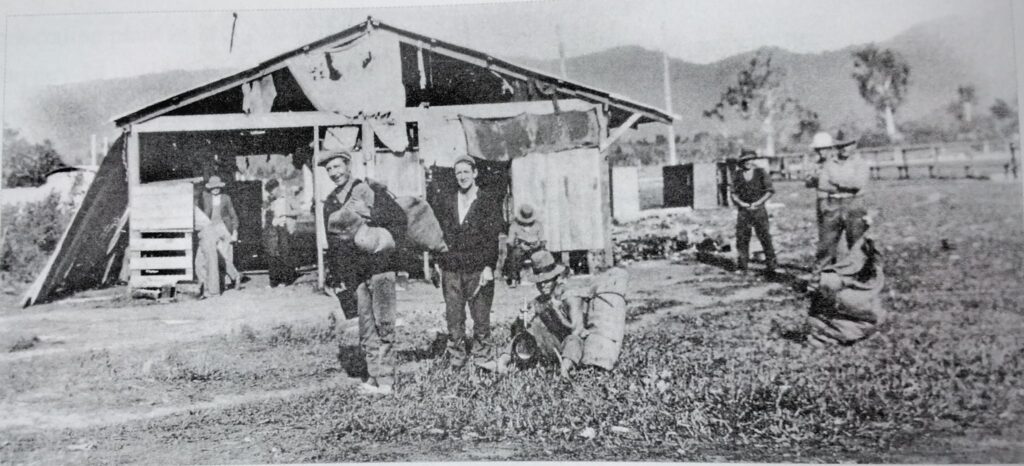
Swaggies living on the Cairns Showgrounds, 1930s.
Photographer: Unknown
Image sourced from: Cairns Then and Now… Facebook Page
THE EARLY YEARS OF SIDESHOW ALLEY…
Amusement rides consisting mainly of Merry-Go-Rounds, Horse-O-Planes, Chair-O-Planes, an Octopus, Tilt-A-Whirl, a scale miniature steam train and an early version of a Ferris Wheel, formed part of Sideshow Alley during the pre-war and immediate post-war years. There were also a variety of bizarre human and animal shows. Illusions such as The Headless Lady, the Indian Rope Trick, a variety of what were known as “in and out shows” featuring all sorts of human and animal freaks, snake charmers and performing animal shows, a glass blower, magic mirrors and the wall of death, while the icon of the “Tent Era” Jimmy Sharman’s Touring Boxing Stadium made it’s first appearance at a Cairns Show in 1932. Games of Chance such as Hoop-La and Knock-Em-Down were also a popular money-spinners.
The use of the “Line-Up Board”, a scaffold-like construction erected in front of the marques was common. The appearance of the spruiker with his megaphone and the cast of the show whether animal or human, attracted an immediate gathering. A helmet-clad male and female riding a motorcycle at full revs on a roller mounted on the line-up board in front of the Wall or Globe or Death, provided a taste of what could be expected during the next performance of the show, which was always”… about to begin on the inside of the giant waterproof marquee”.
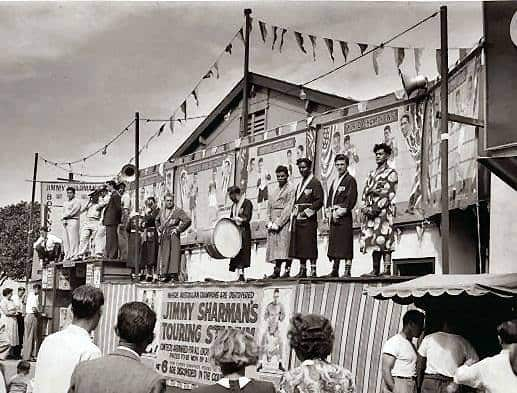
ARENA ENTERTAINMENT POPULAR…
Special entertainment n the main arena was popular from the Show’s earliest years. Acts such as Joe Ashton’s performing Shetland ponies, The Russian Cossacks, Red Tapsall and his wonder horse Don always drew a crowd. Perhaps one of the most unusual of all the early attractions was a performer billed as “Dare Devil Demos”, known in America as “the man without fear”. After several dives from a tower into an above ground pool containing six inches of water, it was claimed Demons would attempt to break his own world record by diving into the six inches of water from a height of one hundred and thirty feet, during the final night of the Show.
Brass bands were also a popular features in the arena, along with displays by local school children.
THE SHOW TRAIN & VARIETY…
Travel until well into the 1960s was confined to rail. So many of the entertainers, merchants, variety acts and itinerant sales peoples travelled the show circuit that on many occasions the show train was split into to sections. Several variety shows including Stanley McKay’s Gaieties, Barton’s Follies, Sorlies Review, The Great Lavante and the most famous circus of all until it’s demise in the mid sixties, Wirth Bros, all tended to follow the show circuit, and depended on train to travel.
The show trains were an advertisement in themselves as they chugged alongside the roads and stopped temporarily at sidings as they approached Cairns. Children would run from their homes to the trains to try and catch a glimpse of some of the performers.
During the first few years at Parramatta Park, the number and quality of sideshows noticeably increased and improved. Every available space being taken up by sideshow operators. One of the biggest names in sideshow business for decades was that of Mr. Arthur Greenhalgh, who imported many attractions from overseas, including the Chinese Wonders Princess Wong and King Chong, and Romonoff’s Reckless Russian Skaters Serge, Sonia and Olga, who flirted with physical injury while performing at breakneck speed on a 8 feed diameter elevated disc. The Little Pigmy Woman Hottentot, was another of the imported identities to appear during the mid nineteen thirties.
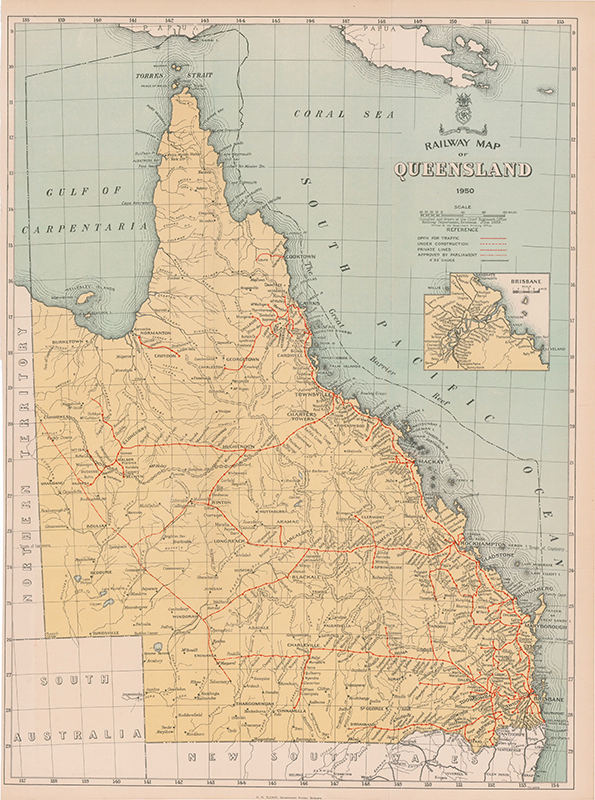
Railway Route of Queensland, 1950s
MAJOR DEVELOPMENTS…
The year of 1936 was of major significance in the history of the Cairns Agricultural, Pastoral and Mining Association. Both the Percy Pease Pavilion and the Grandstand named in honour of Mr David Headrick, (Show President 1932 – 1946) were used for the first time. Even more important, was the granting of the lease of Parramatta Park to the Association, for a twenty-year term.
Local business firms including A J Draper, H M Svendsen, H R Kennedy, Armstorng Ledley and Stillman, Cummins and Campbell, Samual Allen and Sons, Bolands Pty Ltd, Alfred Taylor Pty Ltd, The Gas Company, Palings Music Store and Cairns Timber Limited all provided wonderful displays in the available pavilions.
Increasing demand for the early types of wireless was fuelled by mounting concerns with news broadcasts of what appeared an imminent war. This triggered further demands for display space.
Although World War Two had broken out in 1939, the Armed Forces took control of the show-ground in early 1941. The show in July of that year went ahead regardless. Arrangements were made with the military authorities for the troops to be relocated to allow the show to proceed.
Additional ground had been reclaimed, more permanent structures added and support from the townspeople and those of surrounding areas increased to new heights each year. However, the show of 1941 was the last until peace was declared. It resumed in July, 1946.
THROUGH THE WAR YEARS…
During the years of occupation by the Armed Forces, a wide variety of sporting events were conducted at the showgrounds. Many involved service persons from the American Armed Forces, thousands of which were stationed in and around Cairns. It was said the showground became one of a very few venues in Australia where three codes of football were played during any one afternoon. A challenge match of Rugby League, a game of Australian Rules and a game of Gridiron between two teams of American servicemen were played.
Regular amateur and professional boxing tournaments were promoted in a ring placed on the slope in front of the main grandstand. The venue later became known as the Bobby Crane Memorial Stadium after one of the best known and most dynamic boxers in the local area died in the Cairns Base Hospital after being knocked out in a contest with an American serviceman. When boxing was at its peak in popularity in Cairns, na,mes like Carlo Prandolini, Normie Archer, Kevin Miles (who used the name of Young Milo), Lex Plowman and Eddie Ah Wong, were some of the top locals.
Buildings on the grounds suffered extensive damage and lack of maintenance during the years of occupation. The Association had to spend £1800/0/0 to return the buildings to an acceptable state after the military forces vacated. The immediate post war years proved vibrant as service people were discharged and returned to their families and their normal life style. There were jobs offering to every available person as efforts were made to restore the severe shortage, or non-existence of manufactured goods and all sorts of other commodities.
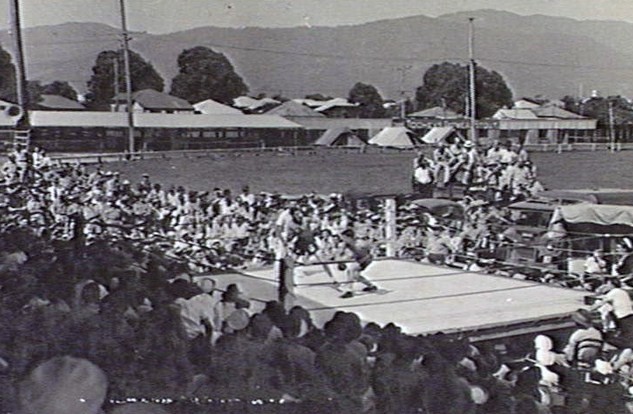
Boxing Match at the Cairns Showgrounds during WWII.
Photographer: Unknown
Image sourced from: Cairns Then and Now… Facebook Page
CAIRNS SHOW – THE HIGH JUMP CAPITAL OF AUSTRALIA
From as far back as 1891, when the first Show was staged by the Cairns Agricultural, Pastoral and Mining Association on September 9th, 10th and 11th, high jumping was included in the catalogue of ring events. A. Longdon’s “Playboy” was written into the Cairns Show record books as winning the first ever Cairns Show High Jump.
During the following years through to 1899 when the Show was relocated to a portion of a property known as Pryn’s at the “Four-Mile”, the high jump continued to attract attention from competitors and the public. Total prize money had reached £30 in 1896, the major share of which was claimed by M. Maddigan’s “Satan”.
During the first Show held at Pryn’s on September 6th and 7th 1899, the first record in the Cairns Show Association’s remarkable high jump history was written, when “Ben Bolt” and rider S. Banning jumped 5 feet 6 inches. H. Alston’s “Kimberley” and “Pebble” equaled the record during the Show held on September 3rd and 4th in 1903. W. Gordon’s “Rocket” claimed victory in 1904, and J. Sutton’s “Johnny” won the event in 1906.
In 1916, a decision was made to hold a Show on September 21st and 22nd, however, the venue transferred to the Woree Racecourse. An open high jump again attracted major attention, resulting in an event restricted to lady riders being added the following year. Miss Isobell Harding proved herself the most successful winning the class with “X-Ray” in 1918 and continued to dominate the outcome through the following few years.
Hec Waugh and “Cakewalk”, who had previously cleared 6 feed 3 1/2 inches during the Atherton Sow of 1916, set a new Cairns Show Association High Jump record of 6 feet 6 inches during the Show at the Racecourse in 1920. Isobell Harding once again dominated the lady’s jumping events. It’s noteworthy that Bill Houston, whose name would later be linked with the most famous high jump in Australia’s, and indeed the world’s, high jump history, was the Association’s president during 1920, 1921 and 1922.
The adoption in 1931 of the former Parramatta Park Sports Reserve as the Association’s future residence, laid the foundation for the Cairns Show’s recognition as undeniably, the “High Jump Capital of Australia”.
The Show in 1931 attacrted two of the biggest names in the list of professional traveling teams of show horses, in those of Perry and Payne. Both names had been previously linked with Australian High Jump Records, the winner of the first open high jump staged on the new showground, Preey Bros “The Hawk” having established the Australian High Jump Record of 7 feet 10 1/2 inches at the Albury Show in 1929. “The Hawk” and rider George Eroni’s successful leap over 7 feet 3 inches claimed victory and the major share of the £31 prize money in the Open High Jump in 1931.
The same horse with riders Pat Crawford and Billy Barton increased the winning height to 7 feet 6 inches in 1932, and 7 feet 7 inches in 1933, before another of Australia’s leading professionals in Ernie Nelson and “Domino” increased the Cairns Show High Jump Record to 7 feet 8 inches in 1934. It is significant that during the annual general meeting of the Association held in December of 1932, a motion moved by R.F.G Fogarty and seconded by Dan Crowley that “All open high jumps at future Cairns Shows should be named the W. J. Houston Open High Jump in appreciation of Mr. Houston’s outstanding contribution to the organisation”, was unanimously carried. Mr. Fogarty’s motion was to link Bill Houston’s name with an equestrian event that during the years from 1933 to 1972 had no equal in similar type event in Australia or anywhere else in the world.
The Open High Jump in 1935 laid the foundation of the uneualled history of high jumping at Cairns Shows and the Parramatta Park Showground. With the Australian High Jump Record increased to 7 feet 11 inches by Ernie Nelson and John Phillip’s “Coaldust” at Wangaratta in the latter part of 1932, no less than three horses jumped the new record height of 8 feet and half an inch to jointly win the W. J. Houston Open High Jump. It was believed at the time to be the first occasion in which a ridden horse had jumped in excess of eight feet on a natural ground surface, at any recognised venue in the world.
Three horses were Perry bros. “Dark Man” and “Lion”, both ridden by owner Ernie Nelson. The height was officially measured by respected engineer and authorised surveyor, P. C. Rutherford.
Controversy arose as a result of an error in the well known Miller’s Sporting Guide that gave credit to a horse called “Cameo” as the Australian record holder, stating the horse had jumped 8 feet 1 inch at the Inverell Show on March 2nd, 1928. Exhaustive enquiries by The Cairns Post, the secretary of the Cairns Show Association, Tom Byrne, and official advice from the Inverell Show Society proved the information was incorrect. “Cameo” and rider Gordon Langworthy had in fact jumped 7 feet 1 inch to establish what became a ground record for the Inverell Show.
The same edition of The Cairns Post carried an article stating that the president of the Cairns Show Association David Heidrick, had received a copy of an El Paso, Texas (U.S.A.) paper in which the photo of “Dark Man establishing a world’s record of 8 feet 0 1.2 inches at the Cairns (Q) Show”. Just one year later, the Cairns Show-ground again came under the national and international equestrian spotlight, with two handsome greys Charlie Perry Senior’s “Lookout” ridden by Billy Barton and Ernie Nelson’s “Euchre” with rider Cyril Grace, increased the record to 8 feet 1 1/4 inches. Cairns Show officials were to some extent doubtful the latest record would ever be bettered, with little or no thought being given to the possibility of a new record being claimed at another show.
However, when information was received that “Lookout” and Billy Barton had jumped 8 feet 3 inches at the Tenterfield Show in February of 1937, £100 over and above the prize money was immediately offered to
a competitor interning the National and International records back to the Cairns Show. Ernie Nelson again ticked his name with a world record when a horse called “Plain Eagle” jumped 8 feet 3 1/2 inches in Open high Jump during Cairns Show in 1937. “Plain Eagle” was ridden by another of Australia’s leading jump riders of that time in Ron Holl.
Apart from the records claimed in the Houston Open High Jump, during the years 1933 to 1937, one of the most remarkable ponies for his size ever seen in an Australian Show-ring was Alan McHardie’s 12 1/2 hands high “Johnny Graham”. With his regular rider George Crook, he added several incredible records. After winning the Local Pony High Jump and dividing the Open Pony event with Perry Bros. “Little Sister” in 1933, Johnny Graham and George Crook’s names became household after they shared a new Local High Jump record of 7 feet 1 inch, with brilliant Malanda based lady rider May Doyle and her own horse “Captain”, in 1934. Their success over 7 feet 3 inches in the Open High Jump was considered even more remarkable. In 1935, “Johnny and Crookie” as they became affectionately known, broke their own local record by jumping 7 feet 2 1/2 inches, and followed by jumping 7 feet 1 1/2 inches before just failing at three attempts at 7 feet 4 inches to the Open.
In 1936, the crowd’s idols again shared the honours in the Local High Jump at 7 feet, before recording their highest successful leap together by jumping 7 feet 3 1/4 inches to earn a place in the Open. In the absence of George Crook in 1937, Ken Aspinall from Grafton was on “Johnby Graham” when the pony again jumped 7 feet in the local event before equaling Thumbs Up’s Australian Pony High Jump record
of 7 feet 4 inches, established at the Brisbane Exhibition in 1920. Sadly, little Johnny Graham’s life was tragically lost in his day yard at home when a mango seed he was sucking lodged in his gullet. A minute of silence observed by a tearful crowd prior to the Open High Jump in 1938 provided fitting evidence of the extent to Which the pony had captured the hearts of Cairns Show public and officials.
Despite attempts to increase the height of the Open High Jump record made in 1938 by “Euchre”, “Plain Eagle”, “Lookout”, “Mandrake” and “Joker”, “Plain Eagle’s” record of 8 feet 3 1/2 inches remained unbroken. Not to be denied, the Show’s claim to high jump supremacy was again emphasised, when J. Thorburn’s “Silver Star” created a new local record of 7 feet 5 inches, Jack and Stella Blanckensee’s “Larrikin” with rider Albie Neal broke “Johnny Graham’s” pony record by jumping 7 feet 6 inches. Their efforts were bettered the following afternoon when Colin Russell’s “Patches” with rider Mick Shearer, established a new Australian and World Under Fourteen Hand Pony High Jump record of 7 feet 7 1/2 inches.
The show of 1939 provided two new Australian and World records. Jack and Stella Blanckensee’s “Larrikin” with Albie Neal claimed the World Under Fourteen Hands Pony record by jumping 7 feet 8 inches, while Colin Russell’s “Flyaway” ridden by Cecil Cayton established a new Australian and World High Jump record of 8 feet 4 inches in the Open High Jump. Twelve horses took part in the event, seven of them successfully jumping 7 feet 9 inches before the record attempt was made. One of Australia’s premier show riders, Beryl Perry was responsible for adding the Australian and what was believed to have been a World Lady’s High Jump record to the Cairns Show’s unmatched high jump history in 1940. With “Plain Bill”, owned and consistently ridden by her father Charlie, Beryl jumped 7 feet 5 1/2 inches to break the previous lady’s record of 7 feet 4 1/2 inches she had established at the Brisbane Exhibition on “Lookout”, the previous year. Although no attempt was made on the open record, “All Fours” and “Joker”, and “Plain Bill” jumped 8 feet to divide the honours in the Open High Jump.
During World War II and the occupation of the Cairns Showground by the military,1941 was to be the last show staged until peace was declared. In 1946. Jack and Stella Blanckensee’s “Peninsula” ridden by George Crook, and Charlie Perry Junior on “Rukin Lass” each jumped 8 feet 5 inches at their first attempt to establish yet another World High Jump Record on the Cairns Showground. When shows resumed in 1946, most of the big professional teams of show horses had been disbanded, leaving doubt in the minds of many that high jump records may ever again be broken, even in Cairns. Both the Perry and A. L. Payne teams however were back on the road, although without most of their former top performers. A chestnut cob-like horse from the A. L. Payne stable called “Gold Meade” ridden by Jack Martin wrote their names, and again that of the Cairns Show into the National and International Equestrian Record Books. To this day, the highest recorded successful leap ever made by a ridden horse on any recognised venue in the world is in Cairns when they jumped the incredible height of 8 feet 6 inches in the Open High Jump. It could be justifiably said that the golden age of the professional teams of show horses, specialist high jumpers and riders had almost come to an end, although the Cairns Showground continued to record heights experienced nowhere else in the country. Jack Martin and “Gold Meade” along with Colin Russell’s “Lone Pine” with rider Miles Gallagher jumped 7 feet 11 inches to divide the Open High Jump in 1947.
With a change of rider, “Gold Meade” with Merv Savage jumped a neat 8 feet in the same event in 1950, Frank Hayden and Colin Russell’s “All Talk” also jumped 8 feet in 1953. In 1957, a locally bred half-draught called “D.D.T.” owned by Jack & Stella Blanckensee ridden by Allen Smythe, created an Australian and World Galloway High Jump record of 8 feet 0 1/2 inches. An attempt to create a new open record of 8 feet 7 inches made by Kevin Bacon and “Kimberley” during the Cairns Show of 1960 proved unsuccessful, leaving Allen Smythe and “D.D.T’s” record achievement as the last occasion on which in excess of 8 feet has been successfully jumped on the Cairns Show-ground, or at any recognized venue in the world.
The introduction of Olympic style jumping contests and their increasing popularity led to the phasing out of high jump events, particularly at Capital Shows, beginning in the latter 1950s. Reduced numbers of entries flowed through to Cairns Shows, prompting consideration of eliminating the event from future ring programmes. Fortunately, information provided by Kevin Bacon in 1961 concerning the introduction of a high jump event over an obstacle designed to the specification of the Australian Equestrian Federation, and his establishment of an official high jump record of 6 feet 9 inches with “Kimberley” at the Mildura Show in Victoria, led to Cairns becoming the second venue in Australia to boast a high jump fence of that standard.
It took just two years after it’s introduction to the Cairns Showground for the first official high jump record to be added to the Cairns Show’s chapters of history. Kevin Bacon and “Spin” won the Open High Jump in 1964, at the new official Australian record height of 6 feet 10 inches. Kevin and “Kimberley” were able to equal that record in 1965 before John Fahey and “Bonvale” shared a new official Australian record of 6 feet 11 inches with Vic Parker and “Silver”, during the 1966 Cairns Show.
Kevin Bacon of Dungog in New South Wales, who has the distinction of having represented Australia in show jumping at Olympic level on three occasions (Tokyo with “Ocean Foam” in 1964, “Chichester” at
Mexico in 1968 and with the same horse at Montreal in Canada in 1976) reclaimed the record again in 1967 by jumping 6 feet 11 1/2 inches with “Satellite”. Kevin and “Satellite” added to the official record height by becoming the first horse and rider successfully over the magical 7 feet at Cairns Show in 1968.
A hefty 5 inches was added to the record height by Peter Mullins and “Tops” in the Open High Jump during Cairns Show of 1969, before the same horse and rider jumped 7 feet 6 inches at the Innisfail Show of 1970, to claim a new official Australian High Jump record. This is the only occasion on which an official Australian High Jump record has been established at another venue other than Cairns. Despite horses and riders consistently jumping in excess of 7 feet, it was not until 1978 that the talented teenager Katrina Towns and “Big John” jumped 7 feet 8 inches at their third attempt to claim the official Australian High Jump record, and what is yet to be denied as a World Lady’s Record.
Katrina and “Big John’s” record remained untouched until dual Australian Olympic representative rider Guy Creighton and “Gulf Country” increased the Australian High Jump Record to 7 feet 9 inches, in the Open High Jump during Cairns Show of 1989. Local teenager Michelle Innis, competing in the open high jump for the first time with a horse called “Rickshaw Star” thrilled what has been described as a “High jump hungry Cairns Show crowd”, by jumping 7 feet 5 inches at their third attempt, before just failing at their three allowable attempts at the new record height.
Just one year later, another incredibly talented young lady, Cathy Green, claimed both a new official Australian, and what has yet to be disproved as a World’s Lady’s High Jump record of 7 feet 10 1/2 inches during the Cairns Show of 1990. Her mare was called “Queen of Hearts”, a natural athlete who excelled in both Puissance and High Jump Events. Cathy Green and “Queen of Hearts” returned in 1993, and long with another Australia’s top jumpers rider in Gavin Chester and a horse called ‘Gallagher”, established naother Australian, we we believe a World Lady’s High Jump Record in drizzling rain. The two horse riders successfully jumped 7 feet 11 1/2 inches in the Open High Jump.
Whether the Cairns Show-ground would ever become the first venue in Australia to record a successful official leap over the magical 8 feet (having achieved that distinction under different regulations in 1935) became the topic of considerable conversation and speculation among regular show-goers. The question was answered in 1997, when two horses and riders were written into the chapters of Cairns Show’s remarkable high jump history. David Mawhinney and “China Gold” became the first horse and rider to jump the new record height of 8 feet or 2.44 metres. Their outstanding effort was equaled immediately by Ron Easey and “Smooth” to the delight of a captivated audience of thousands.
Since and including the year of 1972 the event has remains the focus of attention in the Main Arena every Friday afternoon of the Cairns Shows. Perhaps it can be justifiably said, there would be few, if any, equestrian events conducted at any other Agricultural Show throughout Australia (including the capital cities) that generate anything like the unique atmosphere, the adrenalin rush and crowd involvement that becomes so evident during the entirety of the Open High Jump.
The question as to whether the ‘World High Jump record of 2.47 meters (established by Captain Alberto Larraguibel Morales and “Huaso ex Faithful” at an international event at Santiago in Chile on February 5th, 1949) will ever be broken, remains a matter of speculation. It is justifiable though to allow a discreet level of optimism, that if that exceptional feat is to be accomplished, it will be during a Cairns Show at the Parramatta Park Showground.
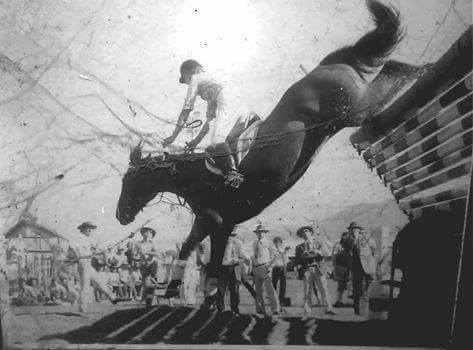
Katrina Towns, Cairns Show 1978
Photographer: Unknown
Image sourced from: Equestrian Memories Australia Facebook Page
THE MR. AND MRS. J. V. BLANCKENSEE INFLUENCE…
Regular Cairns Show followers of the immediate pre and post-war years will well remember the names of Mr. and Mrs. J. V. Blanckensee, residents of the Atherton Tablelands township of Millaa Millaa and their link with a “stable of Equine Stars” destined to include three unofficial World Equestrian High Jump Record Holders.
Jack and Stella Blanckensee began their competitive association with the Cairns Show in the mid 1930s, claiming their first three of three Australian and unofficial World Records with a little bay pony bred on a dairy farm on Pheasant Road at Millaa Millaa. Ridden by local Tableland resident Albie Neal, the duo won the Open Pony and Galloway High Jump at the record height of 7 feet 8 inches, during the Cairns Show of 1939.
In 1941, during the last Cairns Show prior to the forced adjournment through the war years that lasted until 1946, Jack and Stella Blanckensee claimed their second Australian and unofficial World Open High Jump Record with a horse bred on Merluna Station and given the name of “Peninsula”. Ridden by another local Tableland resident, George Crook, “Peninsula” jumped 8 feet 5 inches to jointly win the W. J. Houston Open High Jump, sharing the honour with Charlie Perry Jnr. and a mare called “Rukin Lass”.
During those golden years of High Jump History, the Cairns Show had indelibly identified its recognition as the High Jump Capital of Australia, as a result of heights repeatedly successfully jumped, but recorded nowhere else in the world. Despite the refusal of the International Equestrian Federation to officially acknowledge the records, undeniable evidence of the validity of the heights successfully jumped and certified on every occasion by a registered Surveyor, offset any major concern in that regard.
BORN THE JUMP…
Although a big proportion of record breaking high-jumpers were either pure or part thoroughbred, there have been many exceptions to this being accepted as a rule. None more glaring example perhaps than a humble little part draught measuring just 14.1 hands high and unintentionally bred on a cane farm in the vicinity of the rail siding of Charinga. Partly mouthed and broken in as an early two year old, the horse then called “Boxer” and owned by the Clemson family of Cairns, made his first appearance in the Cairns Show ring in 1950.
Despite his undeniably humble and ungainly conformation, with well-known local jockey and jumps riding enthusiast Jack Grey, as his rider “Boxer” jumped 6 feet 11 inches to divide the honours in the Local High Jump, with the experienced combination of Allan Neary from Townsville, and “Warrior”. Casting aside the horse’s appearance, Jack and Stella Blanckensee immediately made a offer too good to resist to buy the horse, resulting in a change of ownership, change of name and rider, and sharing the Open Pony and Galloway High Jump at 7 feet 3 inches with Colin Russell’s experienced and widely travelled “Lone Pine”, during the 1951 Cairns Show.
The next two years were comparatively quest for D.D.T. and rider Hermann Stotter, their greatest and most thoroughly deserved achievement, together their claim of the honours in the W. J. Houston Open High Jump with a successful attempt at 7 feet 5 inches, during the Cairns Show of 1954.
The 1956 Cairns Show saw the inclusion of two top-line interstate identities in Bill Armour from Melbourne and Kevin Bacon of Dungong in NSW, the Open High Jump divided at 7 feet by Kevin Bacon’s Victory and Neil Power’s “Homer”. Incidentally, “Homer” was ridden by Jimmy Gordon from Collinsville.
HERMAN STOTTER RETIRES…
The Stotter brothers, Hermann and Albie, had been showing horses and competing in jumping events at their home town, Innisfail Show, from the beginning of the post-war years, producing a number of better than average horses. Both Hermann and Albie combined riding the Blanckensee team of jumpers with their own at Innisfail Shows, before Hermann was engaged to travel the Queensland coastal run of shows with the team in the early 1950s. Day to day pressures and demands of cane farming eventually caught up. However, Hermann decided to retire from the the competitive scene, while Albie joined the Innisfail Show Committee, and served tirelessly until he passed as a Life Member, having reaching the age of his early eighties.
It was at the Atherton Show in 1955, Jack and Stella Blanckensee’s problem of finding themselves without a ruder was solved, when a young chap from Monto by the name of Allan Smyth was recommended and introduced to them. So began a three year relationship between Jack and Stella Blanckensee, their “stable of Equine Stars” and a young fellow from Monto destined to write his name indelibly in the pages of unmatched history surrounding the Cairns Show’s W. J. Houston Open High Jump.
Allan Smyth wasted no time in developing a trusting relationship between himself and the horses of the Blanckensee stable, winning the Local High Jump on a new-comer to the team in a horse called “Loch Lomond”, during the opening day of the 1955 Cairns Show. Allan followed that initial success by winning the W. J. Houston Open High Jump on another comparative new-comer to the team in a big heavy framed mare called “Emerald Isle”. Despite the obvious risk involved with High Jump competitions, injuries to horse and rider have thankfully been both minimal and minor.
Both Kevin Bacon from NSW and Bill Armour from Melbourne again brought top-line teams of jumpers all with interstate Royal Show experience and success, making the competition in the Open Jumping events during the 1957 Cairns Show of extremely high standard. The Blanckensee team from the Atherton Tableland weren’t entirely left out, however, with long serving member and prolific winner of Hunting Contests Admiration, a more recent addition a thoroughbred the renamed “Loch Lomond”, and the high-jumpers “Emerald Isle” and “D.D.T.” in the team.
A total of five horses were engaged in the Open High Jump, the entrants including “Emerald Isle”, “D.D.T.”, Bill A’s “Remote”, Kevin Bacon’s brilliant pony “Bobs”, 1956 winner “Homer” and Ted Cunningham’s “Cavallo”. “D.D.T.” and “Bobs” had already met in the Open Pony and Galloway High Jump in which “D.D.T.” failed at this three allowable attempts at 6 feet 6 inches, giving outright honours to Kevin Bacon and “Bobs”. One of the unique characteristics that belonged to the humble little half-draught was that any height below around 7 feet seemed to fail in attracting his attention, or perhaps even his respect. This trend had been demonstrated repeatedly since drawing attention to his phenomenal jumping ability by clean jumping the heavy and high timber Cairns City Council Pound Yard fence, before his first appearance in a competitive arena. The fact that he had been half mouthed when roughly broken in as an early two year old didn’t help the rider either. “D.D.T.”, as Allan once said, was likened to driving a loaded truck down the Kuranda Range with faulty steering.
GOLDEN YEARS OF THE W.J. HOUSTON OPEN HIGH JUMP…
Just turning the clock back briefly to the golden years of the W.J. Houston Open High Jump which highlighted the Cairns Show’s final afternoon ring programme, Sideshow Alley and the exhibition pavilions became virtually vacated as the crowd gathered in anticipation to enjoy another chapter in the pages of incredible history surround the W. J. Houston Open High Jump. No other single event drew the interest of a show crowd to match that experienced during the entirety event, or in fact in conversation among regular show patrons for weeks prior to the Show. Not a vacant seat would be found in the David Headrick Grandstand at least an hour before the event was due to begin, while it was standing room only at every vantage point around the main arena.
ENTERTAINMENT, SOCIAL ACTIVITY & HIGH FASHION…
The resumption Show in 1946 drew record crowds, proving once again the show’s unmatched popularity as both a source of entertainment, and a hub of social activity. People traveled from a wide area to the north and south, the Tablelands and further West. Entries in an expanding catalogue of events and classes were also drawn from an ever-increasing distance. Strong support was received for the Dairy Section, while entries in the Fat Cattle Classes were drawn from as far as Wrotham Park Station, to the north of Chillagoe.
From the earliest years of the annual show, people of all walks of life somehow managed to put aside enough money to enable them not only to attend the show, but to dress in the finest clothes they had at their disposal. Those that could afford the additional expense helped frock salons and tailors to increase their incomes markedly, by purchasing a new show outfit to join in what may well have been described as a “Fashion Expose”.
Special arena attractions provided additional variety to the traditional equestrian and jumping events presented in the arena. The extremely popular and superbly trained Cunningham Rangers featured in immediate pre-war, and early post war years.
Trotting had formed part of the arena program from the show’s beginning although progressing through various stages and forms. During the nineteen thirties, William Trimm and his wife traveled the show circuit from the northern part of New South Wales through to Cairns, bringing with them several horses that had raced successfully at the Brisbane Exhibition.
The inclusion of trotters brought to Cairns by the professionals traveling the circuit saw the sport become more and more popular. This led to the formation of a Trotting Club in Cairns in the early part of the 1950’s. Trotting remained one of the favourite arena events until well into the 1990’s when trotting was eventually phased out of the program.
Steer riding was also included for a few years during night sessions with the additional novelty provided by what were known as “chariot races”. A single drawbar from the chariot was attached to a device girthed to the steer’s back. A slip pin enabled the steer to be released at the end of the race. Collisions were frequent, and with the total absence of suitable safety fencing around the arena, let’s just say that luck prevailed.
Jimmy Bartley from Myola, who worked bullock teams hauling timber for many years, had an enormous Friesian bullock in his working team called Whiskey. For a few post war years, a challenge was issued with a considerable cash prize, to anyone interested in trying to stay aboard the bullock for ten seconds. Many tried, but none succeeded during Whiskey’s years at the Cairns Show. Miles Gallagher from Charters Towers lasting longest of the challengers by staying aboard for around eight seconds.
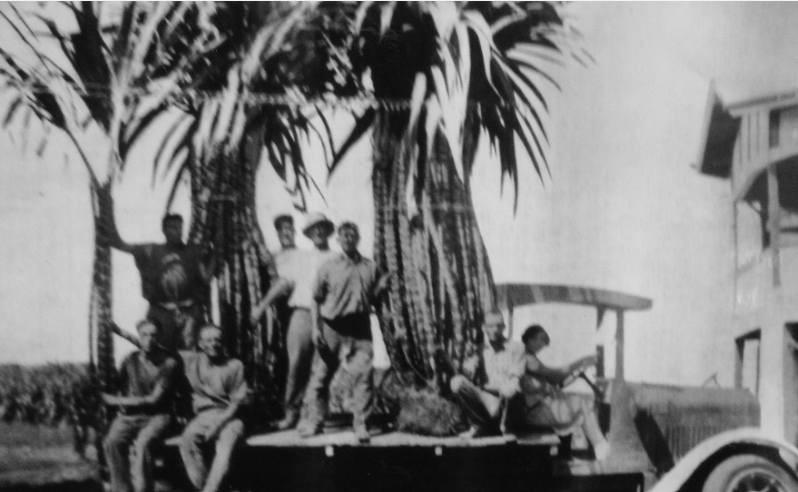
Cane farmers off to the Cairns Show, 1920s
Photographer: Unknown
Image sourced from: Cairns Then and Now… Facebook Page
A RIGHT ROYAL OCCASION
The Cairns Showground played host to the Royalty during a brief visit of Queen Elizabeth and Prince Phillip to the city in 1954. Children were assembled on the arena and thousands gathered to catch a glimpse of the Royal couple. After the Royals departed, most locals remained to join a variety of events involving school children to mark the celebration of the occasion.
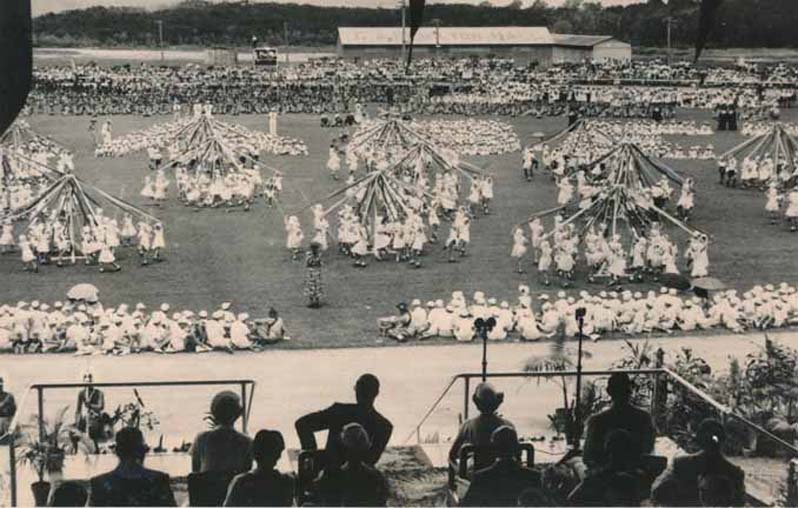
Queen Elizabeth II and Prince Philip observing the Maypole Dances at the 1954 Cairns Show.
Photographer: Unknown
Image sourced from: Cairns Then and Now… Facebook Page
A MULTI-PURPOSE VENUE…
From its early years the Cairns Showground had become the major sporting venue in and around Cairns. During pre-war years, greyhound racing meetings on two different shaped tracks were held. In the post-war years, the Cairns District Rugby League adopted the show-ground as their headquarters, major cricket matches between local representative and visiting teams were played. Combined programmes of cycle and motorcycle racing under the lights on the quarter mile track drew large crowds of supporters. Registered harness racing began in the early part of the nineteen fifties, while the pavilions were also used for a wide variety of activities.
SURVIVING THE SECOND CYCLONE…
The Remington and Stillman halls were added in 1951 while a substantial loan, arranged in the same year, allowed for further reclamation to be carried out. Then disaster struck in 1956 with cyclone Agnes.
Buildings on the showground suffered major damage. The entire roof of the Grandstand was blown off, Fogarty Hall left leaning precariously, the motor pavilions, horse and cattle stalls completely demolished, while corrugated iron off the perimeter fence was strewn around several nearby residential streets.
Again demonstrating the determination of
the Association, and the strength of voluntary help from business firms and townspeople, the show of 1956 not only went ahead, but record attendances and gate takings were recorded. Sideshow entertainment also took on a new dimension in the mid fifties, when names like Slim Dusty, Chad Morgan, the Le Garde twins, the teenaged brother
and sister combination of Ricky and Tammy, Normie Rowe, Johnny O’Keefe and the fabulous Prince Tui Latui and the Maori Troubadors appeared on the banners in
front of Sideshow tents.
Jimmy Sharman’s Boxing Troupe continued to attract major attention. The beat of the drum and sound of the bell from the line-up board where the dressing gowned fighters would appear, created a scurry as patrons flocked to the front of the tent. Each time the names of the Black Bomber and the local hero and state champion Carlo Prandolini were included in Jimmy Sharman’s pre- session spiel, a rush to the ticket box was guaranteed.
1956 was to see the first appearance in the Cairns Show-ring of Kevin Bacon from Dungog in New South Wales, who dominated jumping events through till his last appearance in 1971. Kevin Bacon represented Australia at the Tokyo Olympics in 1964, Mexico in 1968 and Montreal in 1976. His mount in Mexico and Montreal was “Chichester”, a horse that became well known to Cairns Show patrons. In 1967, Kevin Bacon and “Chichester’s” presence along with John Fahey on “Bonvale” and Sam Campbell on “April Love” provided further proof of the high standard of horses and riders the show has continued to attract. The three riders and horses then represented Australia at the Mexico Olympics.
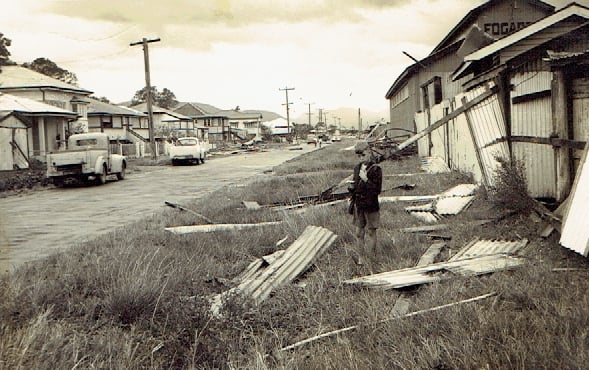
Aftermath of Cyclone Agnes outside the Showgrounds, 1956
Photographer: Unknown
Image sourced from: Cairns Then and Now… Facebook Page
ANOTHER MAJOR ACHIEVEMENT…
The De Jarlais Pavilion was the next major addition to the permanent structures on the showground. With aid of countless hours of voluntary labour the pavilion was built at an original cost of $64,000. Officially opened on April 15th 1967, the building has since undergone major improvements with a extensive upgrade and expansion prior to the 1990 show.
Major alteration was made to the arena perimeter in 1973 in readiness for the introduction of night harness racing which began on June 1974. The track distance increased from the original 440 yards to 720 metres. With the closure of night harness racing however, the track distance was again changed to the current 520 metres.
During the nine years of Mr Fred Moule’s lead as the Association’s President, which began in 1978, improvements were made to the surfaces of the many pedestrian ways and streets on the show-ground. Sealing of all road surfaces has proved enormously beneficial to patrons and exhibitors, and has added significantly to the Cairns Showground’s recognition as the best regional show in Australia. The Fred Moule Pavilion, which replaced the Percy Pease and the Stillman Trade Pavilions, is the most spacious and modern on the grounds.
HIGH QUALITY ENTERTAINMENT…
Over the years, the Show Association has continued to include the best available arena attractions many of which have been featured at the shows in Brisbane, Sydney and Melbourne. In 1966, immediately after appearing at the Cairns Show, The Human Cannon Balls, a brother and sister, who were blasted out of a huge cannon were immediately contracted to the American Ringling Bros, Barnum and Bailey’s Greatest Show On Earth. Among others were Don Williams and his spectacular Fountain of Fantasy, The Flying Lotahs and their internationally acclaimed Aerial Spectaculars, the amazing Brophy Brothers, Warren and Ashley and the Flying Angels, Rusty Frame and Damian Kerr and the nationally acclaimed Holden Precision Driving Team are just a few of the top-line performers who have provided high quality entertainment as part of the Cairns Show’s entertainment.
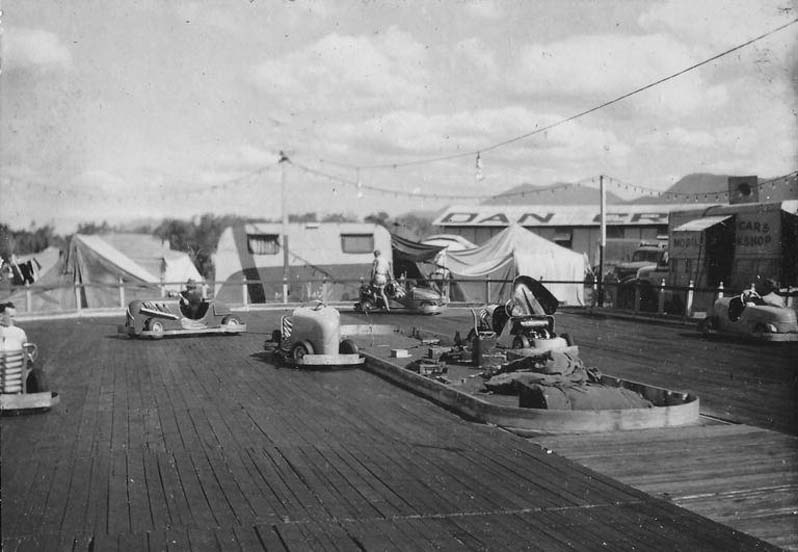
Dodgem Cars, Cairns Show 1940s
Photographer: Unknown
Image sourced from: Cairns Historical Society
THE END OF AN ERA…
Many of the older generation will fondly remember the “Tent Era” at the show. The beginning of the end of this historic involvement with the shows of Australia began in 1972. The familiar sounds from the Sharman’s drum and bell were eventually silenced by bureaucratic pressures, freak shows of all kinds were banned, while television continued to stimulate public demand of a superior level of entertainment. The Amusement industry read the demand and turned its focus to high speed, sophisticated, multi-million dollar rides, leaving the canvas tents, the colourful banners and the line-up boards as the Sideshow Alley of a bygone era.
Despite the ever-changing demands and expectations of the paying public, the Cairns Show Association continues to attract the support of the Showmen’s Guild of Australasia, the business fraternity, competitors and exhibitors, and a patronage drawn from the local and wide surrounding area. One of many long-term aims of the Association, has been to direct available funds raised into the improvement and maintenance of the showground facility, for use by the community of Cairns and surrounding district.
CAIRNS SHOW TODAY…
The Cairns Show is Australia’s Largest, Regional, Agricultural Show attracting approximately 70,000 visitors across the three-day event annually.
In 2014 a crowd of 79,682 people attended the Cairns Show which makes it the largest community event in Cairns. During the three days of the Show more than 400 local industries promoted their products and services.
- 2018 attendance: 73,375
- 2019 attendance: 74,884
- 2020 numbers and figures were expected to rise. Unfortunately, due to the COVID 19 pandemic, the 2020 Cairns Show was cancelled, and in 2021 figures were significantly impacted.
- 2021 attendance: 58,438
- 2022 attendance: 69,691
- 2023 attendance: 65,517
- 2024 attendance: 67,400
A FACILITY FOR THE CAIRNS COMMUNITY
All profits from the Show are applied to improvements and maintenance of the showground facility for the community of Cairns. Over the past 8 years more than $2 million has been spent improving the Showgrounds infrastructure and facilities. This valuable community asset, last valued at over $33 million, has been developed and is maintained at no cost to the Cairns community.
This has been achieved through the voluntary committee and associated organisations giving of their time to complete most of the works. The present Show Committee and committees over the past 110 years have given tens of thousands of hours of their time for the benefit of the local community.
Information collated from the Cairns Agricultural, Pastoral and Mining Association.
Thank you to all who contributed!
Last updated: October, 2024
Vale Her Royal Majesty Queen Elizabeth II
In a time of mourning we, with all the members of the Commonwealth, express our sincere condolences to the members of the Royal Family.
The longest reigning Monarch in British history, the Queen’s selfless dedication to duty and service has inspired generations of people over the past 70 years.
Today, we take a moment to reflect on the past to March 1954, when Her Majesty the Queen visit the Cairns Showgrounds. While the visit was brief, it was nothing but memorable.
Over 5,000 of Cairns’ 20,000 population came to the Showgrounds to see the iconic Monarch. The crowd was so great in fact, that the temporary grandstand we hired gave way.
A story in the Cairns Post reported on the Queen’s expression of sympathy to those who attended.
” ‘I thank you very much, Mr. Mayor, for the fine welcome you have given me to Cairns,’ she said. ‘But I am concerned and I hope nobody is seriously hurt.’ The Queen was thought to be gracious and kind, and ensured the crowd was okay before proceeding.”
Along with this story, we’re delighted to share a photo of Her Majesty Queen Elizabeth II and Prince Phillip, and Mayor Fulton, examining the exhibition at the Cairns Showgrounds in 1954.
Photographer: Unknown
Image sourced from: Cairns Historical Society
Information sourced from: the Cairns Post and Cairns Museum.
